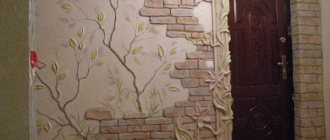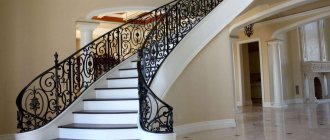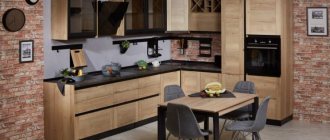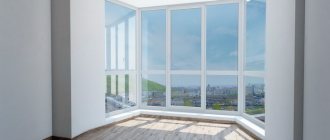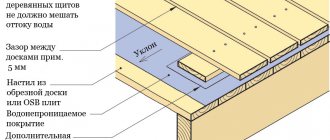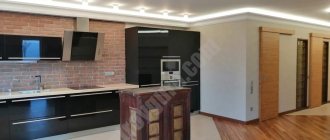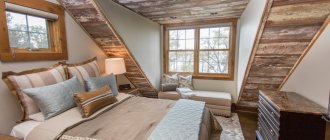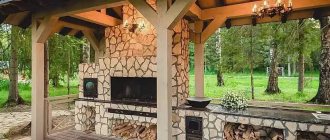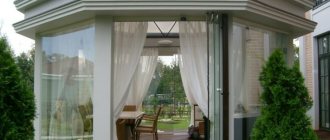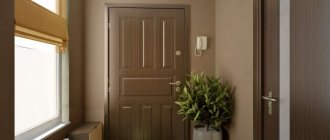Many private house projects include a veranda. It can be either built-in (constructed during the construction of the house) or attached (usually it is done when the house is already built). The veranda is an important part of the house, where people often set up a recreation room, grow plants, and make a workshop.
In this article we will look at what main functions this extension performs, what materials are best to make it from, and how to properly equip and decorate it.
Why is a veranda needed and what are its functions?
The veranda is a small room attached to one of the walls of the house, and is intended for organizing summer recreation. Depending on the type of construction, it can be open or closed. Although most often, people build summer outdoor areas with a canopy and railings.
The main functions that this structure performs include:
- additional insulation of the house;
- protecting the front door from drafts;
- protecting the house from intruders (if we are talking about a closed building);
- increasing sound insulation in residential premises;
- availability of additional space for organizing a recreation area.
What you need to know about building a veranda
The veranda can be included immediately in the house design, or it can be completed later. For example, you decide to change the design of your country house, or you want to expand its area by adding a veranda.
You can make an extension by turning to specialists for help, or if you have certain skills, then do it yourself. In this case, you need to find out and take into account the following points:
- Does the layout of the house allow for a terrace or veranda? Maybe in your country house there are windows on all the walls, eliminating the possibility of additional construction.
- If the desire to have a veranda is great, and the presence of windows does not allow this desire to be realized, an open summer terrace may be an option.
- The veranda can be attached from the entrance to the house, but, like the terrace, it can be arranged against any suitable wall. If this option is suitable, think about which side would be preferable: sunny or shaded.
- If a foundation for constructing an open terrace is not always necessary, then a foundation for a veranda is usually needed.
- A well-laid foundation is the lion's share of success in construction, so only undertake making a foundation with your own hands if you have experience.
- The depth and dimensions of the foundation must be taken into account taking into account the load depending on the materials that will be used in the construction of the veranda. This should be especially taken into account if the design of the veranda assumes that it will be made of brick and with several windows, or will be completely glazed. Glass is a heavy material.
Open veranda with an unusual roof
Of course, it’s great if you can do absolutely everything with your own hands. But if suddenly some points are controversial for you, or you have never built anything at all, the best option would be to contact a construction company, the list of services of which includes not only construction work, but also planning, design, and landscape work.
When a company carries out all construction and design work in a complex, specialists know and take into account all the nuances that arise during the construction process. Then there is a guarantee that everything will be done efficiently and for a long time.
Cooperation with a construction company is optimal even if the extension is large-scale. There may be a need for various approvals from the relevant authorities. As a rule, construction organizations and companies involved in repairs and construction take upon themselves the resolution of all issues related to approvals.
However, it is up to you to decide which construction option is most suitable for you. If you decide to do everything yourself, the main thing is to have great passion and desire to learn. And then everything will definitely work out for you!
Round sofa on the veranda
Terrace with roof and fireplace
Stone benches on the veranda
Simple veranda decor
The kitchen easily turns into a terrace thanks to sliding doors
How to arrange a veranda: choosing a style
Usually, the veranda is made in a rustic style and is completely lined with wood. Although some owners of private houses prefer other stylistic directions:
- hi-tech . Modern furniture with chrome elements is installed here, household appliances are placed (if the room is closed), roller blinds or roller blinds are hung on the windows instead of curtains;
- modern _ It implies the use of both classic and modern furniture items, decors and other things;
- minimalism. Here preference is given to monochrome tones, straight lines and a minimal amount of furniture;
- baroque. It implies an abundance of luxurious and pompous accessories, the use of expensive finishing materials;
- Mediterranean. When decorating the interior, preference is given to marine shades and prints, as well as wicker furniture.
Which style to choose, each home owner decides for himself, based on the landscape design, the general architecture of the building, his financial capabilities and personal wishes.
Attention : when choosing a color scheme for decorating a recreation area, you should pay attention to which side of the house it is attached to. If it is the south side, preference is given to cool colors, and if it is north - warm.
How to decorate a veranda?
There are no specific rules for decorating country verandas, so rely on your taste. Simple wicker furniture on the summer veranda is a decoration of the space in itself. Add curtains to block out the sun in hot weather. Multi-colored decorative pillows can become a bright accent. Experiment and don’t forget to use photos of completed projects to create beautiful veranda projects. If you are just looking for ideas for renovation and arrangement, or already know for sure that a veranda is your option, we have collected for you 125,775 photos from real projects of interior designers, decorators and architects from Russia and around the world, including such proven professionals as John Kraemer & Sons and Tim Cuppett Architects. The beautiful verandas in our photographs are the best examples of competent design and layout in different styles and colors. If you like any design option, for example the veranda from the second photo, you can contact the author and order the ideal design project for yourself. See our photo gallery, look for inspiration and professionals, and you will see why Houzz is the best resource for apartment and home interior design, renovation, home construction, architecture and landscape design.
General requirements for materials
Decorating a veranda in a private house, inside and outside, involves the use of high-quality and proven materials. When choosing them, you should consider the following:
- resistance to sudden temperature changes. At the same time, attention is paid to which side the building is located on (sunny or northern), whether it is heated or not;
- humidity inside. Depending on it, the room can be sheathed with plastic or materials based on cellulose fibers;
- how long ago the building was built. If less than a year has passed (provided that the extension is wooden), then the process of shrinkage of the building has not yet ended. Therefore, you should not choose too expensive materials, or even better, wait a little before starting repairs.
Finishing the veranda from the inside
Owners of suburban areas often have a question about decorating the inside of a veranda in a private house; you can find a lot of examples of photos, but choosing something specific is quite difficult. The design of this extension must be approached thoughtfully, because this is where home comfort and harmony of the surrounding nature meet. Let's consider the best ideas for arranging a modern veranda, interior furnishings and decor.
Terrace, veranda, porch - what are the differences?
A veranda is a place conducive to relaxation and rest, especially if it is beautifully decorated. Here you can enjoy the silence, fresh air and sounds of nature. Today, many people confuse the concepts of veranda, terrace and porch - let's look at each of these additional buildings separately.
The terrace is an open area raised above the ground surface, equipped with fences that are not related to the general structure. This flooring, as a rule, is constructed on a prepared foundation.
This design can be characterized as follows:
- located outside the main building;
- has a hard floor covering;
- can be equipped with a canopy or be open on all sides;
- may be a building separate from the house, connected to it by a staircase or, for example, a boardwalk;
- it is possible to build a summer kitchen or barbecue area inside;
- if there is no roof, you can install an awning - a variant of a canopy on a supporting frame.
A porch is an element of the exterior of a private house, located above ground level and simultaneously performing two important functions - decorative and practical. It is designed to protect the front door not only from uninvited guests, but also from bad weather: strong winds, heavy precipitation, snow and hail. How the porch can be decorated and equipped:
- railings;
- stairs;
- steps;
- roof (optional).
The veranda, in turn, is a small extension with a roof (a mandatory element) and a good view of the street, which is part of a residential building. Features of a modern veranda:
- unheated room;
- can be insulated;
- structure closed by fences or walls;
- has a common foundation with the house;
- is an additional area of a country dwelling and is included in the documentation;
- may be an extension or built simultaneously with the main residential building;
- often has wide, large windows;
- can be equipped with a patio - exit to the street;
- It can be open or glazed.
Inside the veranda, you can, if desired, equip any room - from the kitchen to the bedroom with panoramic windows, having previously built a heating system. A great idea would be to create a stunning Winter Garden with green plants and beautiful flowers, which can be seen from the street.
Varieties
A veranda is a small room or extension connected to the house by at least one wall. This design is most often intended for use in the summer, since it is not equipped with a heating system. But if you wish, you can make the site closed and insulate it.
What types of verandas can be found today:
- open - usually equipped only with a canopy and perimeter fences. They can be located under a common roof with the house, an excellent option for spending time in the summer and in sunny, windless weather. Vertical supports can be used to create a strong frame. Open verandas are usually associated with an abundance of light and fresh air. And to hide from the scorching sun on a bright summer day, you can install umbrellas and decorative canopies;
- closed - glazed structures, the walls of which are most often made of the same material as the cladding of a residential building. It is recommended to build closed areas on the side of the house that is hidden from prying eyes. In this case, you have the opportunity to equip an insulated bedroom or living room with direct access to the garden or yard.
The structure can be combined with the entrance area or have a separate entrance if its extension was carried out after the completion of the building itself. The interior decoration of the veranda in a private house is shown in the photo below; inside there is a cozy dining room with individual access to the garden.
Selection of finishing materials
The interior decoration of the veranda is not only beautiful furniture and decor, but also the cladding of all surfaces. The choice of materials will depend on the size of the entire structure, ceiling heights and layout features.
Before building your own veranda, if it was not previously provided for in the house plan, you must take into account the following nuances:
- It is better to complete repair work before the onset of frost in order to avoid soil squatting or the structure moving away from the walls of the house;
- The main thing is to maintain harmony in the facing materials of the main structure and the extension itself. Harmony of execution style and color scheme is also important;
- For exterior decoration, experts advise using siding, plastic panels, decorative stone, lining, brick, etc. It is better to sheathe the veranda with the same material as the private house itself. For the interior arrangement of the room, you can resort to the same materials;
- To build a site, you will need to purchase special tools: a plumb line or building level, an electric drill, a hammer drill or a jigsaw, as well as fasteners for fixation - nails, screws, sockets for slats, etc.
Most often, for the interior wall cladding of modern verandas they use:
wooden lining is a board made of solid wood, a durable and environmentally friendly option. Standard lining is a material about 22 cm thick; absolutely all internal surfaces can be sheathed with it. It is recommended to cover with a final protective water-repellent and fire-resistant layer;
MDF panels - a wide range of colors, practicality and ease of installation. The material does not accumulate dust and dirt on the surface, is easy to process, can be used as a base for painting, and is easy to maintain;
PVC panels - plastic finishing is not affected by humidity and is resistant to sudden temperature changes, suitable for cladding both walls and ceilings. There are models of panels that look like wood, brick or stone. They are easy to install and dismantle; even a beginner can handle the job. Among the advantages, we can also highlight a reasonable price and a huge selection of products for different styles and designs;
rubber - this material requires special attention because it has truly unique properties. This kind of rubber coating used on the floor surface is resistant to impacts and mechanical damage, does not leave scratches and black marks from shoes. Rubber has an increased level of moisture resistance and does not fade in the sun;
decorative plaster - used for walls and ceilings only if it is a separate closed and insulated area. Here everything will depend on the owner’s imagination - you can choose any option: from Venetian and “stone” plaster to liquid wallpaper with embossed dense fibers.
Ceramic tiles, laminate, parquet or linoleum are suitable for floor covering. Open areas can be covered with decking (garden parquet) - this is a deck board that is most often found on the floor of terraces. If you plan to arrange a separate living room inside the veranda, you can lay carpet or just soft rugs.
In addition to the listed materials, rubble stone, basalt, marble or sandstone are sometimes used for the internal arrangement of the veranda space. This way you can lay out the floor, giving the interior a special luxury.
What can be equipped in a glazed closed structure:
- living room;
- dining room;
- kitchen;
- bedroom;
- nursery;
- gaming;
- library;
- cabinet;
- workshop;
- dance or fitness room;
- bathroom.
You can insulate the room by installing heaters inside - then you can use the veranda all year round without fear of freezing. In this case, both suspended and suspended ceilings will be relevant. You can provide lighting, install chandeliers and spotlights. Lighting can also be built into walls and floors to create a special atmosphere.
Interior decoration ideas
A carefully thought-out interior of the veranda will give the building a special look, because from an unsightly room you can make a real corner for creativity, a summer kitchen, and even a platform with a mini-pool. Let's consider the best ideas for interior decoration and design:
- for the “rustic” Country style, wicker ceilings made of veneer, bamboo or thin plywood sheets are suitable. The wooden planks of the frame can be coated with a darker varnish so that the materials contrast with each other. And the chandelier can be made in Eco or Modern style;
- Using tiles, you can beautifully pave the floor, combining elements of different colors and sizes, creating a feeling of slight deliberate negligence. Tile pieces also look great when paired with a subtle pattern or print. True, before starting work you will have to prepare the floor covering well and level it so that the material does not crack or deteriorate during use;
- The good thing about linoleum is that it is impact-resistant and inexpensive. In addition, it is possible to choose any color and pattern, even imitate wood or stone. You can always lay a soft carpet on a cold floor;
- Here you can arrange a guest room with separate beds and cozy decor. The ideal solution would be to install ceiling fans that can save you from the heat in the summer;
- A hammock will look great on the veranda, in which both household members and guests can rest and relax. This option is more suitable either for an open-type extension or for a room with glazed walls;
- A separate master bedroom with a large bed is a great opportunity to wake up with the sunrise. Decor and furniture items are suitable in light colors with forged elements and ruffles in a romantic style;
- Stone cladding looks beautiful: untreated natural stone combines well with large frames, beams and wide windows. It is better to decorate the room in oriental or country style;
- An ideal option for a dacha and country house would be to arrange a space inside the veranda for receiving guests or a spacious dining room. In this case, you can install wide windows with panoramic views and even make the ceiling transparent. Part of the roof can be glazed with polycarbonate, and blinds, light curtains or roller blinds can be hung on the window openings.
The interior arrangement of the veranda must be well planned depending on the functions it will perform in the future. After all, certain furniture, decorative elements and equipment are suitable for each room.
Furniture and decor
Of course, to furnish an extension that is not a living room, it is better to use garden furniture (designer or homemade, for example, made from rattan or pallets). A wide range of modern models will allow you to create a unique veranda design.
These would look great here:
- rocking chairs;
- plastic and rattan chairs;
- hammocks;
- wicker furniture;
- products from pallets;
- poufs;
- coffee tables made of glass, PVC or wood;
- forged structures;
- homemade furniture from scrap materials.
The furnishings of the veranda depend both on the quality of the wall decoration and on the arranged furniture. What materials are most preferable:
- Plastic is an inexpensive and practical option; you don’t mind replacing such furniture with new ones every season;
- Palm vine (or rattan) - requires special care, can be brittle and fragile, but does not deteriorate under the influence of an aggressive environment;
- Metal - forged structures look graceful and elegant, and are also durable. A minor drawback is the need to periodically treat individual elements with an anti-corrosion compound;
- Wood – the most popular are oak, larch, pine, ash and maple. The most environmentally friendly and successful option in terms of quality and appearance. Wood will suit any style, fit into any interior, and it is also easy to process and can be painted in any shade.
According to the type of configuration, garden furniture can be folding, stationary and modular. Often used are lockers and tables on casters, soft swings and hammocks for relaxation, as well as chairs and dining tables made of logs or pallets.
Let's consider interesting solutions for decorating the interior space of verandas - both open and closed (separate):
- to set up a cozy reading corner or home library in a closed extension, use upholstered furniture, tables, as well as shelves and niches with lamps that will provide the room with artificial lighting at night;
- here you can make a games room, which is especially important for families with small children. To store toys, use boxes decorated to look like soft benches; it would also be a good idea to install them in a play swing, and lay a soft woolen one on the floor;
- In the Winter Garden, among the plants and flowers, wicker furniture, various hanging pots and portable flower beds look beautiful. It is better to choose natural colors for finishing, for example, green or brown;
- If you plan to create a personal home workshop, in addition to work surfaces and equipment, you will need storage systems for tools: drawers, racks and hanging shelves. A small sofa in the sitting area would also be nice;
- To organize a creative space, it is better to give preference to the Loft style, use original tables with low legs, tables for storing materials and art supplies, install several lamps so that there are enough light sources. In this case, it is not necessary to finish the ceiling - in a loft interior this will only be a plus, then you will have a real art gallery;
- a fireplace will come in handy on any veranda, because it is possible to install decorative options. At the same time, in finishing, designers recommend using more natural materials or their imitation, for example, linoleum “like wood” or plaster “like brickwork.” Retro-style candlesticks, leather or wooden furniture are suitable as decor, and the shades should be pleasant and natural (coffee, red-brown, gray, sand, olive, etc.).
It is important to understand that pieces of furniture for open verandas and terraces must withstand not always ideal weather conditions, which means you need to choose a material that is resistant to moisture and temperature changes. If desired, the surface of chairs or tables can be treated with a special protective impregnation. The view below shows a master class with step-by-step instructions on how to make a rocking chair for your dacha with your own hands.
What kind of drapery is suitable for decorating window openings:
- Blinds – universal window design, a huge range of configurations and sizes will allow everyone to choose something for their interior;
- Roller blinds - suitable for both the glazed version and the gazebo format;;
- Light curtains - flowing translucent fabric will be more appropriate in closed-type extensions, since they will not be able to protect from wind or rain;
- A set of various fabrics and tulle - can be used in a classic interior;
- Kissei - you can purchase ready-made products or make them yourself from bright ropes, threads, fishing line, fringe and beautiful beads;
- Acrylic outdoor curtains are able to repel various dirt and dust from their surface;
- Bamboo panels are excellent protection from sunlight in the veranda-living room or kitchen;
An extension to the house is made so that it becomes an additional place for rest and relaxation, which is so necessary for a modern person. Therefore, it is so important to think through not only the external cladding of external walls, but also the arrangement of the internal space. The video below shows a photo selection of options for finishing the ceiling of a veranda in a private house indoors.
Source
Rating of finishing materials for the veranda
Studying the TOP of the best finishing materials used when covering the terrace, it is worth highlighting the following:
- MDF panels . Their composition is dominated by wood particles, therefore they are environmentally friendly and safe. But this material is suitable only for the interior design of closed premises;
- Plastic. It is used for cladding open verandas, as it perfectly withstands moisture, sudden temperature changes and is resistant to mechanical damage.
- Tree . This can be either edged boards, lining, OSB boards, etc. Each individual option has its own advantages and disadvantages.
- DSP . This option is the most budget-friendly and quite acceptable. Cement particle boards are not afraid of moisture, have an aesthetic appearance and are inexpensive.
Improvement of ceilings
Since the ceiling surface bears quite heavy loads, reliable materials are selected for its construction. They must be: durable, light in weight and moisture resistant. From the above requirements, it is worth highlighting the following materials suitable for the ceiling - wicker and polycarbonate. They not only look aesthetically pleasing, but are also easy to install and do not require special maintenance.
When choosing polycarbonate, it is worth considering that it can be monolithic or cellular, transparent or colored. The weaving has an original appearance. For its arrangement, veneer or thin moisture-resistant plywood is used.
Veranda flooring
So, how to decorate a veranda so that it is practical, aesthetic and easy to use? For finishing floors the following are used:
- terrace board;
- porcelain stoneware;
- rubber;
- linoleum;
- cement.
When choosing materials, it is worth considering the following: will the room be heated during the cold season, will you walk on the floors barefoot, in street shoes or in house slippers.
Important: in a closed and heated veranda, you can lay a carpet on the flooring.
Design options for a veranda in the house
There are many different options with which you can decorate the interior of the veranda. Here are some ideas that can help in this matter.
Veranda with glass roof
Even a small veranda with a transparent roof will look much more interesting and lighter. The big advantage will be that it will be light there almost all day, and you can feel lightness and simplicity in the room.
Article on the topic: Cross-stitch patterns according to the cells of the picture: small for children, easy 50 to 50 for beginners
In this option, combine the color of wicker furniture with wood trim, which will create a truly comfortable and cozy atmosphere.
If the veranda space is large enough, you will have the opportunity to place a dining and living area there.
The central element and highlight will be frosted glass with wooden beams. At the same time, it is good if the color of the beams echoes the overall interior.
Natural stone and wood
Stone is very often used to finish floors in the veranda area.
It also goes well with rough-hewn frames that might contain landscape paintings. Thus, it will seem that the person is in close proximity to all the beauty of nature.
Veranda in bright colors
Using light colors will first of all allow you to visually expand the space of the veranda, and will also play an important role in the sensations, because when the room is decorated in light colors, a feeling of lightness and calm is created.
A veranda in white tones represents the design of such parts and elements as a window frame, ceiling, furniture, floor lamp, bedside lamps and other interior items.
Speaking of flooring, there are two options, both of which are absolutely win-win. You can make a contrasting style that combines light trim and dark flooring, or you can do everything in white shades.
How to decorate the walls on the veranda inside
Decorating a veranda in a private house involves the use of all kinds of materials. For interior wall decoration, home owners use:
- clapboard _ It can be placed in both vertical and horizontal positions. It is better to choose a lining with a thickness of 5-10 mm. It can be made of either wood or plastic;
- decorative plaster. This could be plaster that imitates natural stone, or Venetian plaster that replicates the texture of marble. Colors are added to the plaster to give the walls the desired color;
- MDF or PVC panels. They withstand temperature changes, are distinguished by high sound absorption rates, and are convenient to use.
Attention : a clapboard veranda is a classic option.
Veranda interior design styles
Agree that each room should have its own individual style. This point will also apply to the veranda, so it’s worth thinking about this issue in advance.
Related article: Stained glass doors: DIY decor
Some of the most popular design ideas that our compatriots choose for the interior of the veranda are the following options:
- These can be various ethnic motifs, in such cases the most common styles are oriental, Mediterranean, Scandinavian, Provence style and eco-style suitable for a wooden veranda.
- The idea is that all furniture should be made exclusively from natural wood, preferably handmade. In such cases, bamboo, rattan, natural fabrics and other various types of wood are often used. It is best to do everything in light pastel colors.
- Very often, pieces of furniture such as a dining table or coffee table are used in the layout of a country veranda. The main thing here is not to overload the space of the room, because it should be spacious and comfortable for relaxation.
How can you sheathe the outside of a veranda?
When choosing what to cover the outside of an extension with, it is worth considering that the materials must be durable, practical, attractive and resistant to negative environmental factors. For these purposes it is best to use:
- polycarbonate This is a completely inexpensive material for which there is no need to create a capital foundation (due to its light weight). Its advantages include: high thermal insulation qualities, interesting design, creation of a favorable indoor microclimate, resistance to moisture, direct sunlight, long service life;
- tree . Despite the fact that it requires careful care, the natural texture of the wood looks very noble and attractive. The advantages of external cladding of the veranda with wood include: the ability to implement the project in any style, environmental friendliness, affordable cost;
- brick . It is distinguished by high levels of strength, reliability and durability. Such a structure will be warm, resistant to negative factors, and attractive. Not the entire extension can be finished with brick, but only the foundation and a few pillars. Decorating the pillars of the veranda with brick looks very noble and elegant;
- metal _ Requires additional insulation, since due to sudden temperature changes, condensation can accumulate inside the room during the cold season. This is a fairly budget option, which is most often used by summer residents;
- plastic _ Completely unpretentious in maintenance, easy to install, not exposed to atmospheric agents, and capable of withstanding heavy loads.
What rooms can be made from a veranda?
The space on the veranda can be used in a variety of ways, setting up a kitchen, living room or workshop there. There are actually many ideas on how you can use space, and here are a few of them.
Dining room on the veranda
This is one of the most popular options that is often used nowadays. Such a dining room is best decorated in a minimalist style, where the main items will be a table with chairs, indoor plants and textile elements.
Veranda-living room
This is a common option in which the main task will be choosing the right size of furniture. An important point will be your preference in choosing a sofa, because a large sofa will look ugly on a small veranda, taking up all its space, just as a small sofa can simply get lost in the room.
Related article: Do-it-yourself mechanism for sliding doors: instructions, diagrams (photos and videos)
Veranda-office
Even on the smallest veranda there is always the opportunity to place a small desk and chair where you can do business, at the same time relax and enjoy the scenery outside the window.
Veranda as a playroom
Surely your children will like their own personal corner, which can be arranged on the veranda. It can be decorated thematically, for example, in the form of a pirate ship or a princess’s castle. It would be very helpful to build a small playground near the veranda where children can spend their leisure time.
Veranda in the form of a winter garden
If you're into green spaces, the porch can become a so-called "staging area" where you can grow plants before planting them outside.
Veranda-workshop
Another pretty good idea, because there you can create your own art studio where you can paint pictures. You can also put a sewing machine there and sew beautiful original things.
Interior decoration ideas
When deciding how to finish a terrace, it is worth considering its type of construction and other factors. It is worth noting that this room can be stylized in any direction. It can be decorated with original furniture, textiles, evergreen seedlings, and stone. In other words, it all depends on the personal wishes, preferences and financial capabilities of the residents.
Furniture for the veranda
When choosing furniture items for a terrace, it is worth considering the type of construction. If the room is open and unheated, products made of plastic, rattan, wood, and metal are suitable. They cope well with various negative factors. The main thing is to choose high quality products.
Wicker furniture items are suitable for buildings made of brick, siding panels or wood. With their help, a comfortable relaxation area is organized where you can have family conversations, drink tea with friends and simply relax in the fresh air.
Wooden tables and chairs please:
- aesthetics;
- durability;
- variety of designs.
But finishing the terrace with wood requires careful maintenance. To prevent rotting, items will need to be periodically treated with antiseptics.
Attention : when choosing outdoor wooden furniture, pay attention to the quality of its fittings and guides.
Metal objects heat up under the sun, fade, and corrode. However, they are affordable and resistant to chemical cleaning agents. Plastic is lightweight, compact in size, and presentable in appearance. Such furniture is completely unpretentious in maintenance and is distinguished by a variety of designs and color schemes.
Plants for the veranda
Living plants can not only decorate any interior, but also create the most comfortable atmosphere of warmth and coziness. They can be planted in pots, allowed to climb along poles, or placed in vases. To decorate the terrace from the street, plants such as crocuses, scillas, tulips, daffodils, and irises are used. For lovers of shrubs, it is worth choosing: rhododendrons, lilacs, spirea.
Attention: fuchsia and petunia hung in flowerpots near the house look very beautiful and original.
For extensions located on the north side, flowers such as heucheras, ferns, and jasmine are chosen. And for terraces located on the south side, roses, peonies, lilies are suitable.
Decor items
Decorative items on the terrace can include:
- finishing materials for walls, floors and ceilings;
- textile;
- furniture items;
- dishes;
- paintings.
When choosing curtains, attention is paid to their functionality and practicality, and then to their appearance. For northern buildings, light organza fabrics are chosen; for southern buildings, they are denser and more opaque.
Lighting is also an important decorative element. When choosing lamps, preference is given to: floor, wall, ceiling sconces and chandeliers.
In conclusion, it is worth noting that we looked at how to cover a veranda at the dacha, what shrubs and flowers are best to plant near it, what style to decorate it in, how to choose the right furniture, and so on. By showing maximum imagination and creativity, owners of country houses can build a comfortable and stylish terrace where it will be pleasant to spend leisure time with family and friends.
